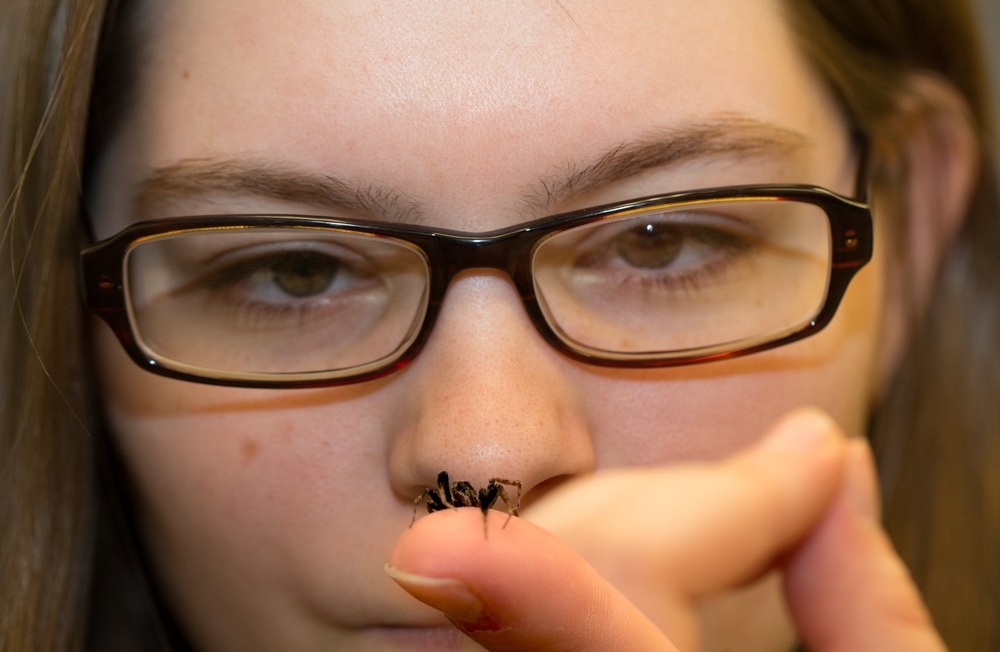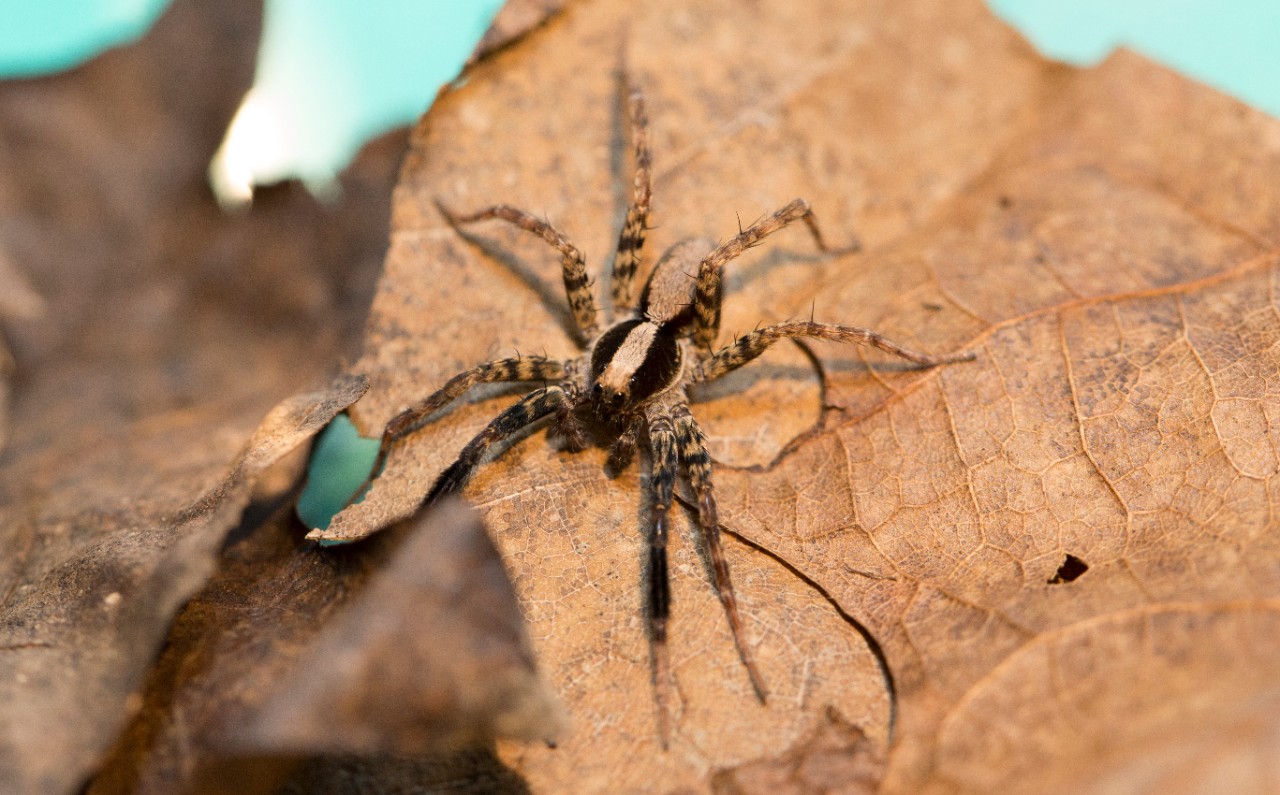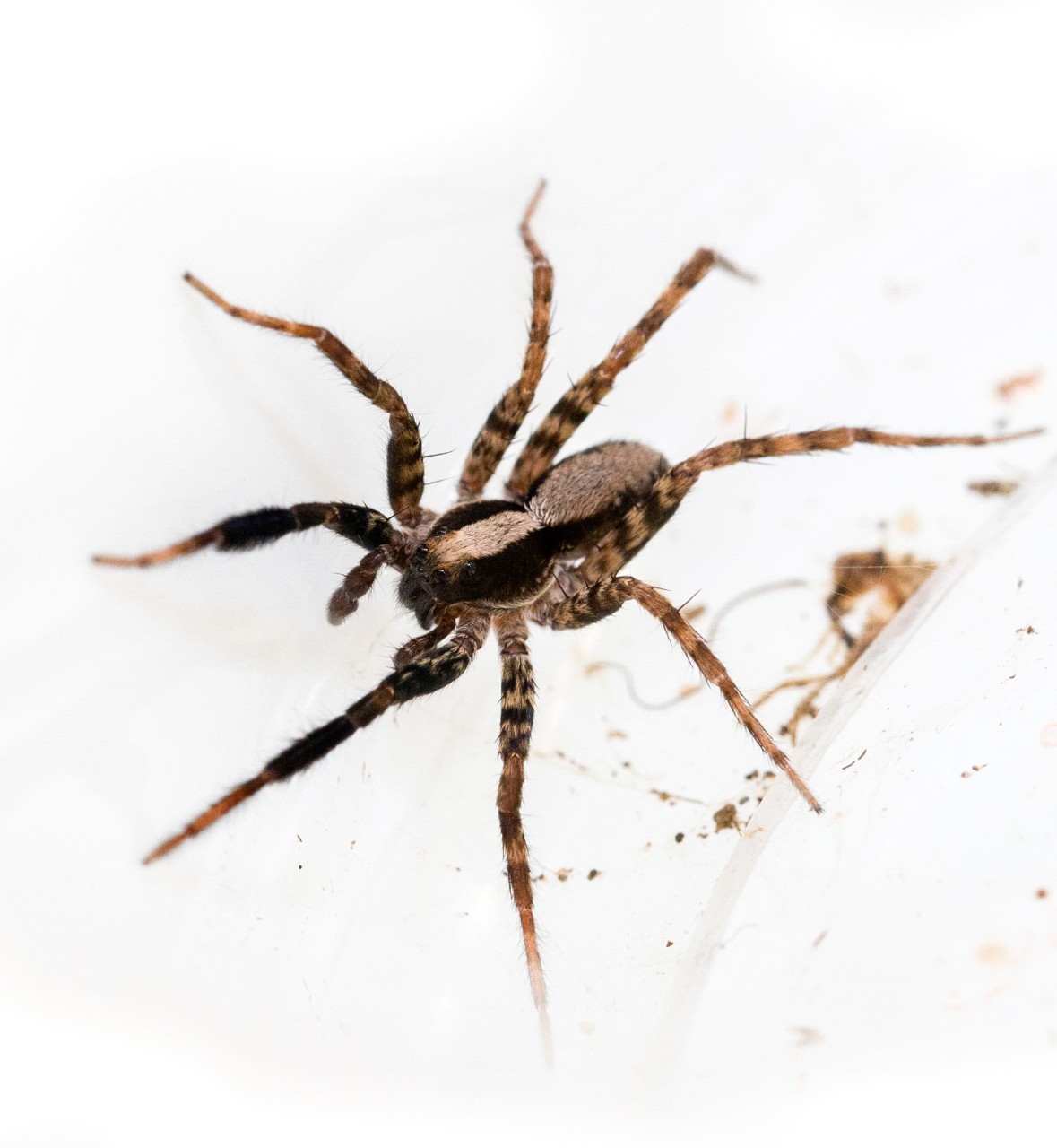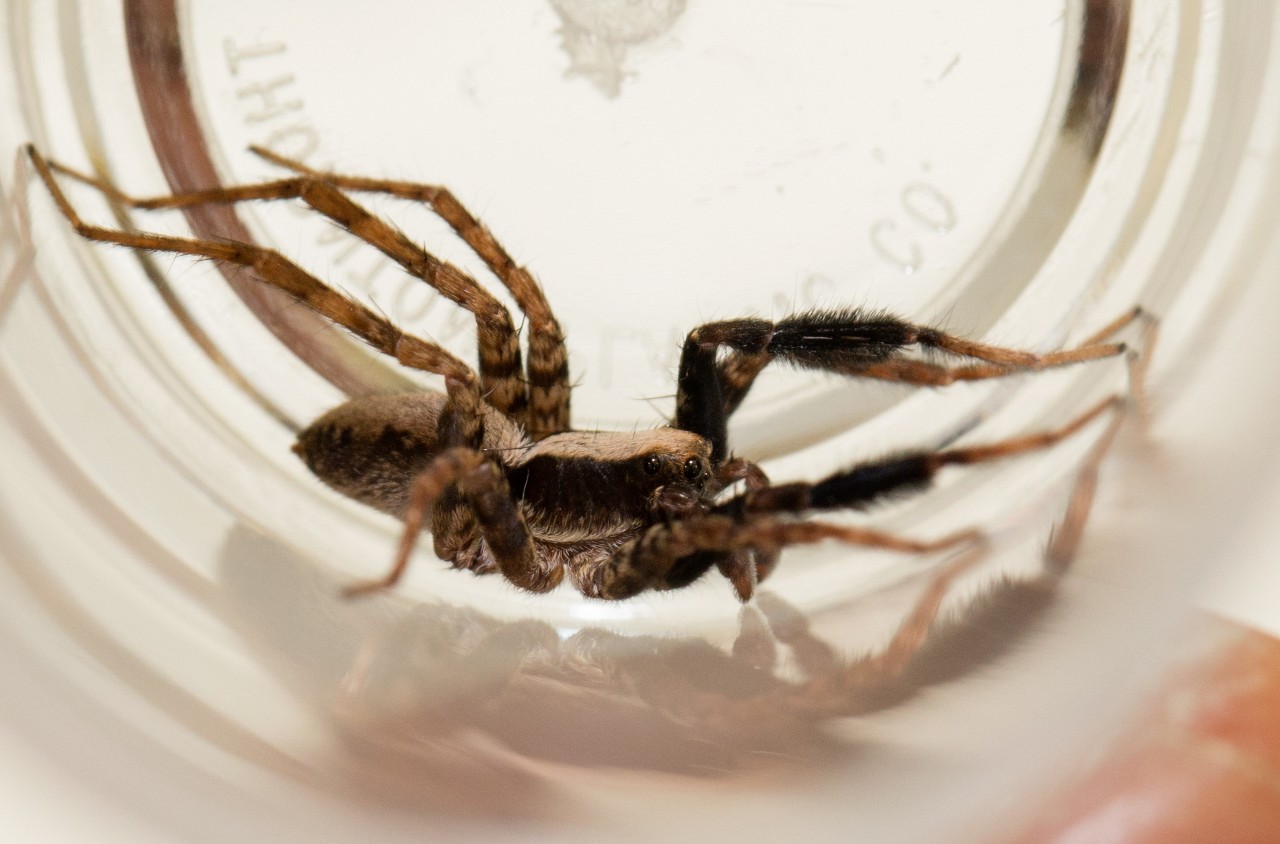Little charmers
UC biologists say wolf spiders have a wider range of personality than once believed. Charisma could make the difference between wooing a female or winding up her meal.

By Michael Miller
513-556-6757
Photos by Joseph Fuqua II/UC Creative Services
March 22, 2017
Charming might not be the best way to describe a spider, but researchers at the University of Cincinnati are finding a wide spectrum of personality in a creature whose behavior was thought to be inflexible and hardwired in its genes.
UC biology professor George Uetz has dedicated his career to the study of spiders, wolf spiders in particular. Spiders are simpler in neurophysiology than mice or other vertebrates, so their behavior should be determined more by DNA than any quirkiness among individuals.
But Uetz said spiders have more charisma than he ever imagined.
“There’s a lot of variability in the individual,” he said. “Some of that that arises from experience, just as in more complex animals.”
More than 200 species of wolf spiders live in the United States. As their name implies, they stalk their prey on the forest floor and in dry creek beds. They are lone wolves, living and hunting on their own except for mating encounters, which are the subject of two studies this year by UC graduate students.

UC biology students such as Madeline Lallo are studying the mating behavior of wolf spiders to learn how closely related species evolved.
One UC student, Emily Pickett, examined two closely related species that look alike and share habitat. While the two spiders can interbreed, it’s rare in the wild. Pickett found that their unique courtship behavior helps maintain their genetic isolation.
One spider, Schizocosa ocreata, could woo females over a greater distance than the other, Schizocosa rovneri, by employing a combination of vibrations and visual signals unique to the species.
“We hypothesized that the two species diverged relatively recently. This gives us good insights into the modification of species — how one species develops into another,” Pickett said.
Since spiders don’t hear the way we do, they rely on vibrations, chemical cues and visual signals to communicate.
A second study by graduate student Madeline Lallo examined yet a third wolf spider, Gladicosa bellamyi, and found that males bounced their bodies and waved their pigmented forelegs like flags to get the attention of females.
The students and their co-author, professor Uetz, presented their findings in March at the Midwest Ecology and Evolution Conference at the University of Illinois. The conference accepted 95 papers from universities across the Midwest.

UC biology professor George Uetz has published more than 120 papers, most of which examine the behavior and evolution of spiders.
UK Daily Mail
Wolf spiders have distinct personalities
International Business Times
Do spiders have a personality?
Tendencias 21
Las aranas desarrollan una personalidad propia
Futura Planete
Students Pickett and Lallo are building on an investigation of spiders that professor Uetz began more than 40 years ago. Uetz has co-authored 120 peer-reviewed papers, chronicling how spiders communicate, select the best mate and learn from their mistakes. In 1976, he compiled a comprehensive list of native spiders found in Delaware.
Scientists often choose fruit flies, nematodes or mice for research subjects because so much is already known about them, including whole genomes. Wolf spiders, too, are fast becoming a template for research because of work at UC and other universities.
“In the long view, we’re building a new model organism for study,” he said. “We know a great deal about [the spider’s] behavior and are learning more about their physiology and immunology.”
Uetz said spider behavior relies on multiple sensory systems completely different from our own and those of other vertebrate animals. Their visual, vibratory and chemical senses provide insights about the evolution of nervous systems and brain function.

UC researchers collect wolf spiders like this one, Schizocosa ocreata, from forests around southern Ohio.
Each new study begins at the Cincinnati Nature Center where researchers collect wild spiders in the forest. Finding wolf spiders with LED flashlights is surprisingly easy at night. (Arachnophobes might say it’s horrifyingly easy.) Their eyes glitter in the lamplight like green gemstones.
“They blend in really well with the leaf litter. But at night you can see all those eyes shining back.
You have no idea how many spiders are actually in your backyard until you put a headlamp on and look,” Lallo said.
Researchers scoop up the spiders and sort them by species and sex.

The eyes of wolf spiders are reflective and glow green in the light at night.
The biology lab is home to as many as 1,800 spiders at any time, which again could make some people anxious.
“For some people it’s a hard, ‘Nope!’” Lallo said. “I understand why some people can be afraid of them. But they’re just too small to bite us.”
Despite their ferocious name, wolf spiders are harmless to people. Researchers casually handle them by scooting them into vials or prodding them around their plastic containers.
Researchers feed pinhead crickets to their experimental subjects twice a week. The spiders drink from a sponge that soaks up water from a recessed reservoir.
Lallo studied the courtship behavior of Gladicosa bellamyi by leaving a female overnight in a clear plastic bowl called an arena. The bottom is covered in a paper disk that helps researchers detect minute vibrations whenever the spider walks, scratches or engages in a courtship dance. Left to her own devices, the female spins a trail of pheromone-laced silk that is irresistible to male spiders.
Males can read chemical cues in silk to determine if a female is receptive, has already mated or even if it has cannibalized other males in the past, Uetz said.
“They will either avoid those females completely — hide and try to be invisible — or else court furiously to overwhelm her senses,” he said.

UC graduate student Madeline Lallo, left, and biology professor George Uetz demonstrate equipment they use to study spider courtship behavior in the lab. They set up a laser doppler vibrometer in a soundproof room to record vibrations that courting spiders make in the soil or fallen leaves. Many species also use visual cues by waving their forelegs.
The next day they place the arena atop a laser doppler vibrometer in the lab’s soundproof recording studio. The laser beam converts vibrations in the filter paper into a digital rendering that researchers can compare side by side with other examples.
They drop a male in with the female and use a video camera and the vibrometer to record what happens.
In about 10 percent of Schizocosa ocreata mating encounters, the female immediately eats the male. The rate of cannibalism can be as high as half of the encounters in other species, so wolf spiders walk a thin line between courtship and consumption.
For a demonstration, they paired two spiders and waited. Up close, the ocreata is camouflaged with brindled brown and black fur. But the male’s forelegs are covered in thick black bristles like a dancer’s leg warmers.
With its antic mating dance, ocreata has a nickname in the lab: “the twerking spider.”
The male raises his fuzzy appendages over his head while bouncing his body and fangs on the ground to create vibrations. Generally, spiders that make the strongest vibrations have the best breeding success, Uetz said.
The researchers watched as the male began to wave his front legs and strike the filter paper.
“Here he goes,” Uetz said. “Here comes the female. Now look at her. She’s interested.”
The female cautiously approached the male and did a curtsy — a spider invitation to mate. The male frantically bounced and waved.
“Yeah, she’s excited. It’s going to happen — unless the male gets a little skittish,” Uetz said.
Despite her apparent willingness, the male ran away to the edge of the arena where he resumed his dance, this time a little less enthusiastically. The female approached again and did another pivot and curtsy but the male again backed away.
“They were close but then she reared up slightly and scared him. She’s armed and dangerous,” Uetz said. “She’s not being aggressive but he is clearly smaller than she is. He doesn’t have a lot of experience.”
After another minute of posing, the female suddenly chased the male in two frantic laps around the arena. Lallo rescued him before the encounter could turn gruesome.

UC is helping to turn wolf spiders into a model organism to study disease or environmental issues to benefit people.
The university’s research has found that each species of wolf spider engages in a unique courtship dance, often employing multiple forms of communication.
“It’s given us insights into the fact that this behavior is plastic. It’s learned,” Uetz said.
In other experiments, Uetz uses virtual reality to study spider communication. Spiders are placed in the arena in front of an iPod playing a recorded video of a spider of the opposite sex.
Researchers play recorded sound through the filter paper that mimics the vibrations observed from the dancing spider on the screen. Incredibly, the ruse works and researchers can elicit a mating response from the live spider.
Wolf spiders are selective about mating only within their species. But researchers can use digital animation to build their own chimeras or virtual hybrids to determine precisely what about the opposite sex stimulates a mating response. Phillip Taylor, a former postdoctoral researcher of Uetz’s who is now an associate professor at Macquarie University in Australia, has taken the research a step further by using magnets to affix a spider to a rolling track ball in front of a three-dimensional screen to build a virtual world in which the spider can run around and interact with digital spiders.
Now UC’s Uetz is turning his attention to the variability of behaviors within species — the advantages and disadvantages of being a bold or timid spider. If a male is too bold, he could get eaten by a female or passing bird. If he is too timid, he could survive but miss any chance to pass on his genes.
“This strong selection pressure to get the message across leads to the evolution of complex, multi-sensory behaviors,” Uetz said. “He might contribute to future generations. Or he might be lunch.”
Interested in wildlife? Apply to UC's undergraduate biological sciences program or explore other programs on the undergraduate or graduate level.